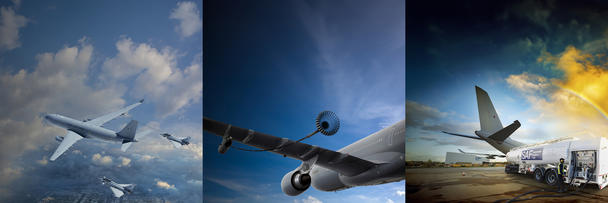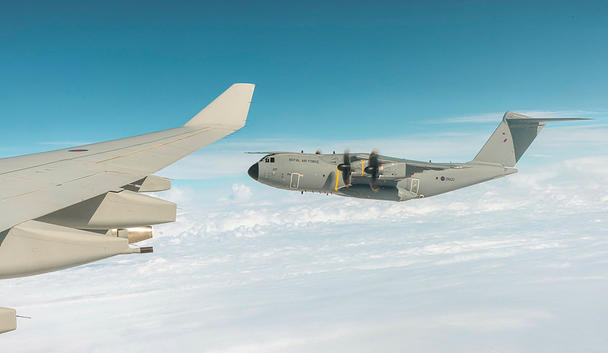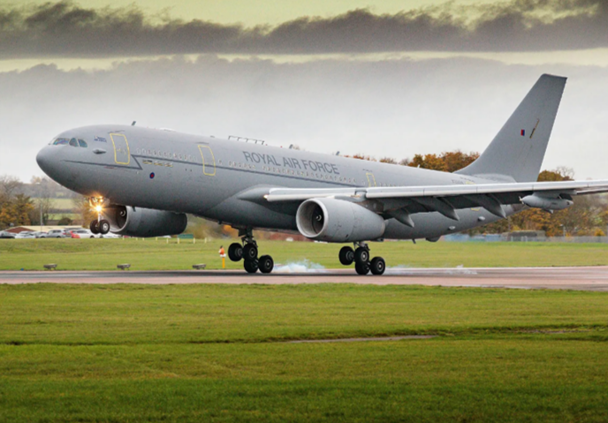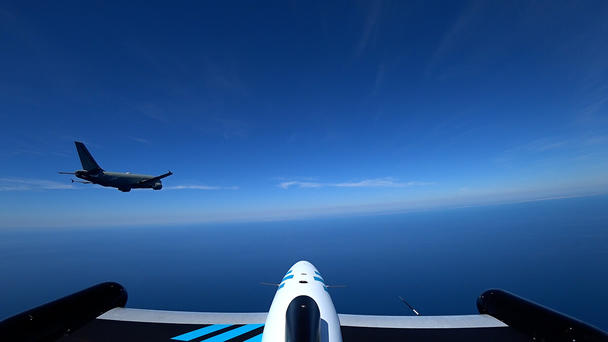Air-to-air refuelling: pushing boundaries for 100 years and beyond

From a visionary concept to a staple of modern aviation, air-to-air refuelling has come a long way in its 100-year history. What is there left to achieve? Quite a lot, actually.
2023 marked a century since two US DH-4B biplanes carried out the first successful air-to-air refuelling mission. Since then, air-to-air refuelling has become a cornerstone of modern air power, extending mission ranges and enhancing strategic capabilities.
Today, the A330 MRTT is leading the charge in modern-day aerial refuelling capabilities. Deployed by air forces around the world, the tanker has logged thousands of flight hours in support of military and humanitarian operations. The Royal Air Force (RAF) is at the forefront of such missions with a fleet of 14 A330 MRTTs in service. Here we take a look at how the RAF is using the aircraft – known in the UK as Voyager – to push the boundaries of air-to-air refuelling 100 years on from that first pioneering flight.

Crown Copyright
A record-breaking flight across the world
Kicking off the deployment for Exercise Mobility Guardian 23, the RAF took on a flight challenge that was sure to go down in the record books. On 3 July 2023, an A400M Atlas departed RAF Brize Norton and flew non-stop to the Pacific island of Guam on the other side of the world. The 7,000-mile journey took a total of 22 hours – the longest flight ever undertaken by a propeller aircraft.
Air Commodore Anthony John Lyle, the RAF’s Air Mobility Force Commander, described the mission as “a great example of our ability to project air power”, showing that the RAF can get aircraft, crews and vital equipment to the other side of the world in a timely manner and for them to be able to operate immediately.
None of this would have been possible without Voyager: the journey included three air-to-air refuelling operations over the Atlantic, Alaska and Pacific. The first refuelling was carried out by a Voyager from 10/101 Squadron flying from the UK, while a second Voyager – operating from the United States’ Eielson Air Force base in Alaska – took care of the remaining two.
Flight Lieutenant Andy York, from Voyager Force Training Flight, saw it as a huge accomplishment of the aircrew involved: “Significant planning went into this exercise and, in the end, it was a great opportunity for us to test out long-range strategic air-to-air refuelling, conducted from forward-operating airports.”

Crown Copyright
Pushing for a sustainable future
As well as setting flight-duration records, the RAF has also set itself the target of reducing carbon emissions and reaching Net Zero by 2040. One pillar of this effort is the switch to Sustainable Aviation Fuel (SAF), which is made from waste-based sustainable feedstocks, such as used cooking oil. With the potential to reduce lifecycle carbon emissions by up to 80% compared to conventional fuel, SAF plays a key role for the RAF to achieve its goal.
At the heart of the transition to SAF stands the Voyager. In November 2022, it became the world's first in-service military aircraft to take flight using purely sustainable fuel. It was also the first time any aircraft had flown in UK airspace using 100% SAF on all engines.
“From the crew perspective, the SAF operation was ‘transparent’, meaning that no differences were observed operationally”, concluded Jesus Ruiz, Experimental test pilot and Captain of the flight. “The Test Plan was exhaustive and robust and has allowed us to compare SAF with JET1 culminating in a flight without a single drop of fossil fuel.”
Since then, the RAF has conducted a number of additional SAF trials. In early 2023, the RAF used SAF blended with regular aviation fuel for the first time in a Eurofighter Typhoon. The fighter jet received the blend as part of an in-flight refuelling exercise from a Voyager aircraft. In April 2023, the Voyager completed yet another air-to-air refuelling exercise, powered by 43% SAF. Taking off from RAF Brize Norton, flying over the North Sea and returning via Farnborough, the RAF’s VIP Voyager, called Vespina, refuelled four Eurofighter Typhoon fighter jets with blended SAF.

100 years and counting
Even though air-to-air refuelling has now been around for a century, the subject is still very much alive. And we haven't even touched on the technological advances that are shaping its future.
For example, the Airbus A330 MRTT recently became the world's first tanker to be certified for automatic air-to-air refuelling (A3R) boom operations in daylight, with a certification for night conditions to follow in 2024. For operators, this means a reduced workload, while refuelling becomes safer and the fuel transfer rate in operational conditions is optimised.
Going even further, Airbus Defence and Space and Airbus UpNext are collaborating on Auto'Mate, a demonstrator of new technologies to enable Autonomous Assets Air-to-Air Refuelling (A4R) and Autonomous Formation Flight (AF2) operations. The idea is to automate the whole process – tankers autonomously guiding a ‘receiver’ aircraft into the proper position, followed by the fuel transfer and a safe separation manoeuvre. Auto'Mate would thus open the door for aerial refuelling of non-piloted combat air vehicles, such as drones.
It is certainly impressive to see how far air-to-air refuelling has come – but the future will be just as exciting.